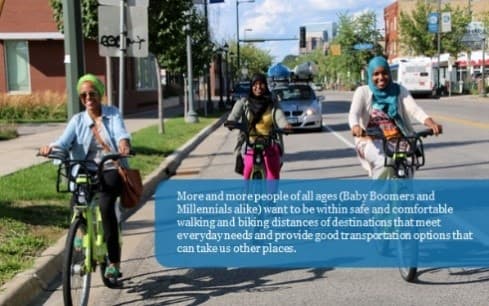Caring for both parents who died with Alzheimer’s weighed on Gloria Grys’s mind. “I was the primary caregiver and financial person for both, and that really influenced me,” says the 76-year-old Wisconsin resident. “I didn’t want to get to age 85 and have my two sons have to clear out our house. So, when we got this opportunity to get a continuum of care, we thought, ‘Let’s do this while we’re young enough to enjoy it.’”
Grys is referring to the move with her husband, Ed, who’s now 77, to a two-bedroom-plus-den unit in the Prairie Ridge campus of Oakwood Village, a senior community in Madison, Wis. “We were on the young side — we moved here when we were 70 and 71 — but the opportunity came, and we decided to take it,” she says.

The couple’s unit is about 1,400 square feet and under a life lease. “You give a bunch of money,” explains Ed. “If you leave or die, your estate or you get back 90 percent. You pay a monthly fee, and your unit is yours as long as you want it.
“The amenities were the continuum of care. You can move from here to assisted living or memory care, and you have priority for those. Once you move into those, they’ll never kick you out.”
With any luck, the Gryses will never need those amenities. For now, they’re embracing all the other amenities the campus offers, from onsite physical therapy to transport to farmer’s markets, dinner theaters and concerts downtown. But what makes the Gryses most content is the sense of community they’ve experienced (and helped build—Ed’s president of the residents’ association, for instance—though they demur if you point that out to them).
They did put some distance between themselves and long-time friends. “Our friends are three hours away—the last place we lived in was for 30 years,” says Ed. “They also said to us: ‘You’re moving to a nursing home?’ It’s a whole different mindset.”
But the Gryses aren’t alone in looking for a home with amenities that will make them feel like they’re part of a community. And in the end, the appeal for amenities that create that experience aren’t all that different from generation to generation.
Behind the Draw for Amenities
To understand how different generations view different amenities, it’s best to have a grounding in generational trends. That’s the job of Chris Porter, senior vice president and chief demographer at John Burns Research and Consulting in Irvine, California.
“I try to understand the dynamics in our country changing not just housing but any business that relies on households and how they’ve changed over time,” he says. “There’s a massive wave of young adults coming of age. A lot of people talk about how big the millennial generation was, but we had more births in the 1990s and 2000s in the United States, and those people are in their mid-teens to mid-30s right now. That will provide a solid tailwind for housing demand for the next decades.
“Their parents did well — they kept moving up and purchasing new homes,” Porter adds. “So, there’s an expectation that the home they’re moving from is how things should be in their first place. Then reality sets in because of affordability. They still want those things, but they have to make some compromises. So, there are amenities they’re giving up and some they’re holding firm on.
“For instance, while there’s a perception that younger generations don’t cook, a kitchen is still important to them,” says Porter. “They don’t need a huge kitchen, but it needs to be functional. They also want entertaining space, but they’d likely take smaller space if a community can provide space where they can host gatherings.”

Top amenities are outdoor trails, a pool, pocket or scattered parks, and outdoor gathering space.
Developers are responding. Porter’s research shows that among the top amenities master-planned community developers would absolutely include in phase one of a development are outdoor trails, a pool, pocket or scattered parks, and outdoor gathering space. Other high-value amenities include sports courts like pickleball and basketball and pet perks like a dog park.
Where the Generations Align
While not every generation sees the same value in various amenities, their desires overlap more than they diverge.
“How I frame my thinking about this is that we’re going to have more people over 50 than under 18 by 2034,” says Rodney Harrell, vice president of family, home and community at the AARP Public Policy Institute in Washington, D.C., whose job includes creating the Livability Index. “How do we have neighborhoods and communities that accommodate people in these communities?
“One thing that’s come to me over the years is that your generation isn’t an issue as much as your ability or disability,” he explains. “It’s about residents’ ability levels. Close to half the people over 75 have a physical disability, while more of the younger populations don’t have a physical disability. But we still have people with disabilities in both groups. So, if we’re thinking about making homes work for aging, we have to think about the needs across the spectrum.”
Harrell says community amenities need to include parks, benches and shaded areas in hot climates. “Those things make areas more usable for anyone who might have a hard time walking a long distance,” he says. “That might help with the older people, but some older people might not need that at all — and the same is true with younger residents.”
Rose Quint, assistant vice president of survey research at the National Association of Homebuilders in Washington, D.C., regularly surveys homeowners on what they want in their home and community. Results show that there are some standard wants across age groups. “It’s true that different generations want different things for some features, and it’s not true for other features,” she says.
The top three outdoor features with the biggest differences between the generations are outdoor fireplaces, kitchens and grills.
Here’s a snapshot of Quint’s findings on the slight variations in generational preferences:
- “The top three outdoor features with the biggest differences between the generations are outdoor fireplaces, kitchens and grills,” says Quint. “Younger groups are much more likely than the boomers to want those three features.”
- “In the community itself, Gen Zers are more likely to want 28 of 29 features listed in our survey,” says Quint. “The only feature that didn’t have any difference by age is being close to retail space. The most extreme differences among the features we ask about are having a day care center nearby, baseball and soccer fields, playgrounds, and good public and elementary schools. And millennials are more likely than boomers to want other things, like tennis courts, a dog park, a ride share pickup spot and pickleball.”
- “Certain home features resonate with all generations, such as laundry rooms, ceiling fans, patios and walk-in pantries.”
- “Most buyers want home offices, but there’s a slight decline with age,” Quint notes. “Ninety percent of the younger groups want at least one home office or some space, and that number goes down to 80 percent of Gen X and 75 percent of boomers.”
Quint’s research aligns with Harrell’s on disabilities. “I was thinking there was going to be a huge difference between the older and younger groups on accessibility features,” she states. “It was interesting to me that, although the older group is more likely to want them, the younger groups still have interest in these things. For example, having a full bath on the main floor is something 70 percent of Gen Zers want. It’s also interesting to me that entrances without steps aren’t irrelevant for the younger group.”
The View From the Rental Side
As any housing insider knows, homeownership and rental housing have different constituencies, and amenities in the rental market are becoming ever more important, reports Caitlin Sugrue Walter, senior vice president of research at the National Multifamily Housing Council (NMHC).
“Especially in markets where you’re seeing a lot of developments come online at the same time, there’s more supply than demand, and folks are having to differentiate themselves to attract consumers,” she says. “What one place is offering in terms of amenities; that could be the reason they’re chosen.”
NMHC’s study of resident preferences is done every two years and doesn’t show a huge difference in demand for amenities among generations, though it does show variations. “I will say that with the tech-related amenities, the younger folks have more of a desire for that,” says Walter. “But it’s not a huge difference. For instance, everybody wants wireless internet capabilities.”
Amenities that were once perks are now expected. “More places now have fitness centers, and new developments have classroom space as part of the fitness center,” she says. “New developments also have electric vehicle charging stations.
Common space is important, and that seems to run the whole generational spectrum.
“Common space is important, and that seems to run the whole generational spectrum. The changes are more in the design of the communal areas. People still want that space to work, but it’s no longer a sterile-looking room where there’s a printer. It’s more of a relaxed deal.”
Walter explains, “I was at a new build a month ago in a very exurban area, and it had a big communal space, but there wasn’t a lot to the space. There was plenty of seating, and there was a lounge area. That space doesn’t necessarily need a lot of things, but residents need a place where they can hang out if they don’t want to stay in their unit. We’re also seeing some higher-end spaces add things like podcast studio rooms that residents can use. People are putting a lot of effort into attracting remote workers.”
Data privacy is even emerging in the home-work space. “One thing I hadn’t thought of is that some remote workers say they need the internet to actually plug into the wall because they can’t just hop onto Wi-Fi,” adds Walter. “It’s not super sexy, but it’s a big thing.”
Walter’s job includes envisioning how rental housing will adapt to today’s older age group. “I spent a lot of my time thinking about the aging population,” she says. “There are folks discussing the community health model, which might include concierge doctors on site. It hasn’t really taken hold, but it’s intriguing.”
She’s also keeping an eye on a rental trend that has emerged. “As millennials have been later to have kids, build to rent—entire communities of single-family rentals in one professionally managed, high-amenitized community—has become a big thing,” explains Walter. “Those communities are very similar to communities with homeownership. They have the space benefits of a single-family home but a lower barrier to entry—people don’t have to worry about coming up with a down payment.
“We are looking at the amenities for those. I'm guessing people will want clubhouse amenities, which is similar to a community with homeownership. That’s what I’m paying attention to.”
Amenities Can Build Connection
On the senior side, Porter says his research shows a growing focus on proximity to family. “The new amenity in retirement isn’t necessarily the golf course but community and being close to your kids and grandkids,” he states.

That was part of the Grys’s calculation. “Like a lot of people, you move where your kids are, and that was a big motivator,” says Ed.
Harrell agrees on the importance of amenities that help build community—he measures them in the Livability Index. “We know there are advantages to communities that have places to interact with neighbors,” he says. “People really like having things nearby, like parks, grocery stores and libraries. Communities that have those things also allow you to stay and thrive in the community of your choice.”
In areas that don’t have the space or funding to easily add community-building amenities, Harrell says smart leaders are finding other ways to plant those stakes. “I know of a senior living community in Florida that, where the community didn’t have things nearby, such as access to grocery stores, they organized bus rides to grocery stores,” he says. “Another one brought in carts to create a mini farmers market.
“But one of my concerns is that those options aren’t available to residents at various income levels. The need will grow to have a range of options not just in housing types but in the assistance residents need. My hope is that we do more to make sure there are affordable options for those.”
Amenities Steps or a Bus Ride Away
Adding amenities that build community is certainly something the Gryses have found huge value in at Prairie Ridge. There’s a fitness center with classes, two woodshops and more. “On campus, we have a bistro, a beauty salon and a little general store you can buy basic things like toiletries and cereal and milk,” says Ed. “We’ve been able to go from two cars to one because of those amenities.”
But they were surprised to find how much they love the warmth of the community. “I’ve been reading about how social connection is important for older adults, and we can’t go anywhere here without running into someone,” says Gloria. “We often go to events together, and Ed comes back earlier because I stop and talk to people.”
Ed’s community has broadened in ways he never expected. “I’ve not been a golf or tennis club kind of guy, but I probably have more guy friends than I ever had in my life,” he says. “We have a handyman club that does things to help residents, like hang pictures. I just got back from a 16-mile bike ride this morning. You get that togetherness and camaraderie.”

All this comes at a cost, and the Gryses are willing to stretch for it. “The monthly fee is close to $3,000, and it’s a bit of squeeze,” says Gloria. “But it’s worth it.”
Building and community amenities are important to all generations and well worth it.
Building and community amenities are important to all generations and well worth it. But surprisingly (or not surprisingly), most ages have similar needs and wants in their homes—even at different life stages.











